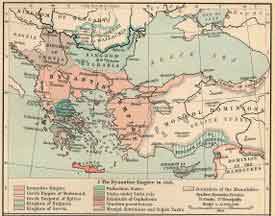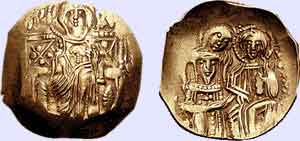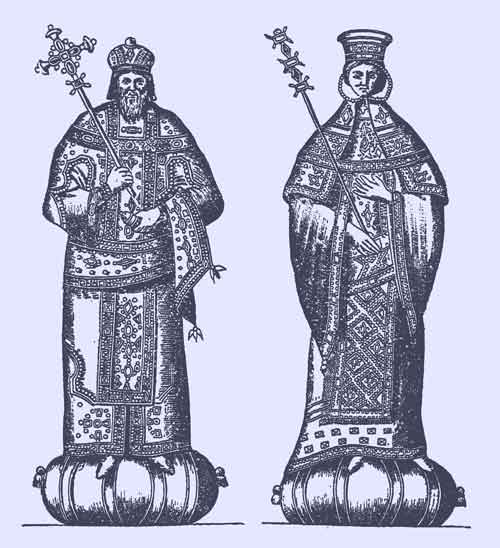.

The Byzantine Empire in 1265 (William R. Shepherd, Historical Atlas, 1911)
Michael VIII (Μιχαήλ Η’ Παλαιολόγος)(1225 – December 11, 1282) was the founder of the Palaeologos dynasty that would rule the Byzantine Empire to the Fall of Constantinople in 1453. He restored the derelict Empire in 1261 and ruled it until his death.
Way to the throne
Michael VIII was the son of the megas domestikos Andronicus Doukas Comnenus Palaeologus by Theodora Angelina Palaeologina, the granddaughter of Alexius III Angelus, the last legitimate Byzantine emperor. Even with our imperfect knowledge of Byzantine genealogy, no less than 11 emperors may be traced among his ancestors. He was one of the noblest men in Constantinople and one who could have been born emperor, if it were not for the Latin Conquest of Constantinople in 1204.
At an early age he rose to distinction, and ultimately became commander of the French mercenaries in the employment of the emperors of Nicaea. A few days after the death of Theodore II Lascaris in 1259, Michael, by the assassination of Muzalon (which he is believed but not proved to have encouraged) became joint guardian with the patriarch Arsenius of the young emperor, John IV Lascaris, then a lad of eight years. Afterwards invested with the title of "despot," he was finally proclaimed joint emperor with the help of the Genoese.
Reign
In 1261, Michael captured Constantinople from its last Latin monarch, Baldwin II. He had himself crowned, with his infant son Andronicus as co-Emperor. Later that year, in December, he had John Lascaris blinded and banished. For this last act he was excommunicated by Arsenius, and the ban was not removed until six years afterwards (1268) on the accession of a new patriarch. After rendering John Lascaris ineligible for the throne, Michael quickly married off John's sisters to foreigners, so their descendants could not threaten his own children's claim to the Imperial title.
On his accession to the throne, Michael abolished all Latin customs and reinstated most Byzantine ceremonies and institutions as they had existed prior to the Latin invasion. His principal ambition was to put the Greek Empire back on the map as a force to be reckoned with. He realized that the danger existed that the Latin West, particularly his neighbors in Italy (Charles of Anjou, Pope Martin IV, and the Venetians) would be unified against him and set out to avoid the mistakes of Manuel I.

Michael kneeling in front of Christ, in this coin issued to celebrate the liberation of the capital of the Empire from the Crusaders. [Source]
In 1263 and 1264 respectively, Michael, with the help of Pope Urban IV, concluded peace with Villehardouin, prince of Achaia, and Michael, despot of Epirus, who had previously been incited by the pope to attack him, but had been decisively beaten at Pelagonia in Thessaly (1259); Villehardouin was obliged to cede Mistra, Monemvasia and Maina in the Morea. Subsequently Michael was involved in wars with the Genoese and Venetians, whose influence in Constantinople he sought to diminish by maintaining the balance of strength between them.
To drive a wedge between the pope and the others he decided to unify the Byzantine church with the Catholic one; a tenuous union between the Greek and Latin church was signed at the Second Council of Lyons in 1274. He did so at a great price at home: his prisons filled with many disgruntled people of Orthodox faith. For a while the wedge worked but in the end Pope Martin IV (working in part for Charles of Anjou) excommunicated him. Then he needed a new wedge and used truly "Byzantine" diplomacy to get the Catalans of Peter III of Aragon to attack Sicily, thus cutting Charles's kingdom in half.
In reconstituting the Byzantine Empire Michael restored the old administration without endeavouring to correct its abuses. By debasing the coinage he hastened the decay of Byzantine commerce. He died in Thrace in December 1282, but his dynasty continued for almost two centuries, longer then any other in Roman history.

Michael VIII Palaeologus, Theodora Doukaina Vatatzaina
Family
In 1253, Michael VIII married Theodora Doukaina Vatatzaina, a grandniece of John III Ducas Vatatzes, Emperor of Nicaea. Orphaned in childhood, she was raised by her great-uncle John III, who was said to have "loved her like a daughter", and who arranged for her marriage to Michael. Their children were:
Andronicus II (1259-1332)
Constantine (1261-1306)
Irene Palaeologina, married Tsar Ivan Asen III of Bulgaria
Anna Palaeologina, married Demetrios Angelos
Eudokia Palaeologina, married Emperor John II of Trebizond
By a mistress, a Diplobatatzaina, Michael also had two illegitimate daughters:
Euphrosyne Palaeologina, married Nogai Khan
Maria Palaeologina, married Abaqa Khan
Sources
Nicol, Donald. The Last Centuries of Byzantium, 1261-1453, 1993
Vannier, J-F. Les premiers Paléologues (Etudes prosopographiques), 1989
Links
Michael coinage: http://www.wildwinds.com/coins/byz/michael_VIII/t.html
--------------------------------------------------------------------------------
Preceded by: John IV Lascaris
Byzantine Emperor
Succeeded by: Andronicus II
--------------------------------------------------------------------------------
This article incorporates text from the 1911 Encyclopædia Britannica, which is in the public domain.
| Ancient Greece
Science, Technology , Medicine , Warfare, , Biographies , Life , Cities/Places/Maps , Arts , Literature , Philosophy ,Olympics, Mythology , History , Images Medieval Greece / Byzantine Empire Science, Technology, Arts, , Warfare , Literature, Biographies, Icons, History Modern Greece Cities, Islands, Regions, Fauna/Flora ,Biographies , History , Warfare, Science/Technology, Literature, Music , Arts , Film/Actors , Sport , Fashion --- |
Retrieved from "http://en.wikipedia.org"
All text is available under the terms of the GNU Free Documentation License

